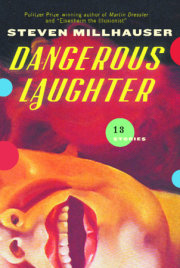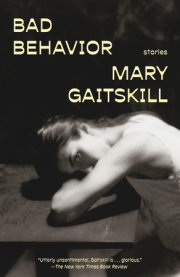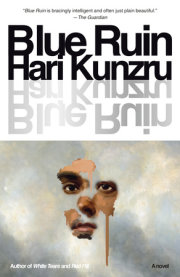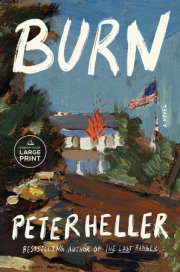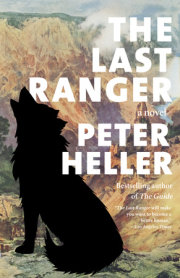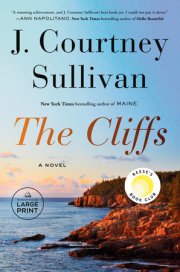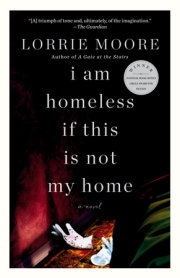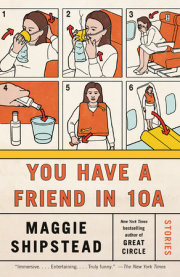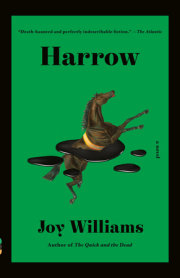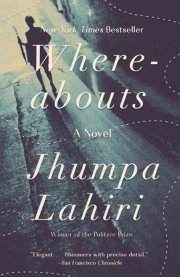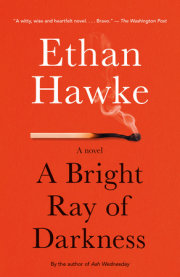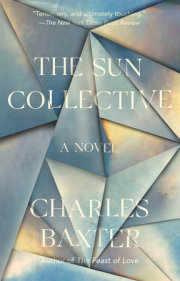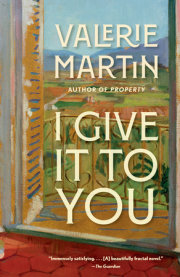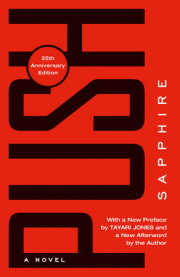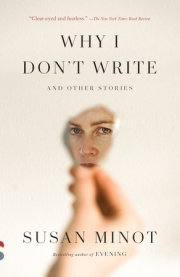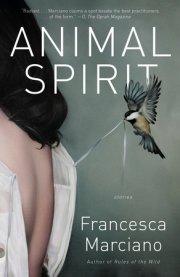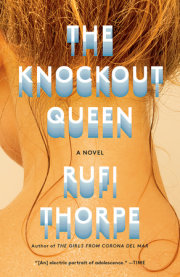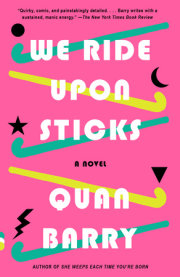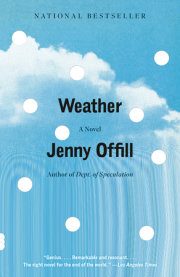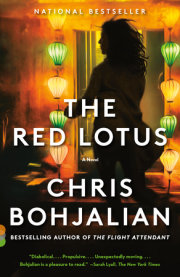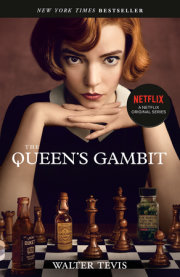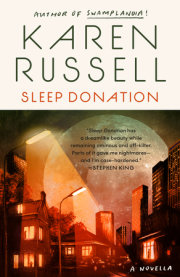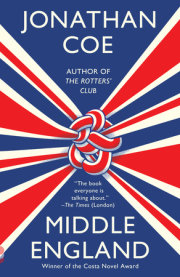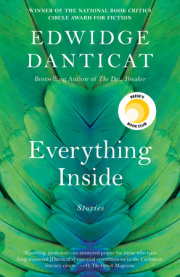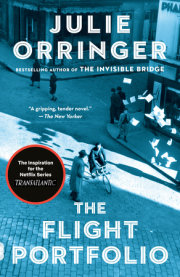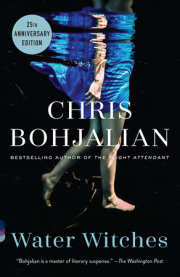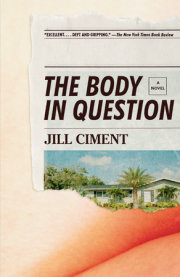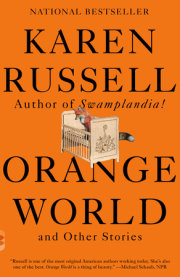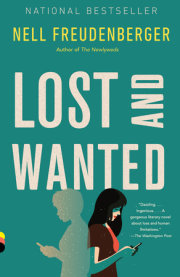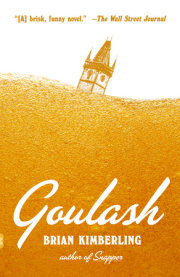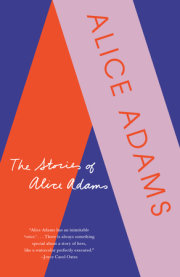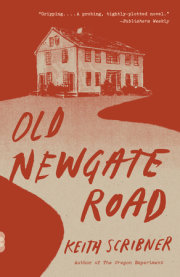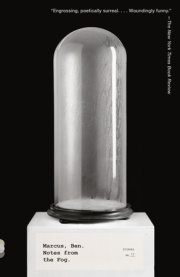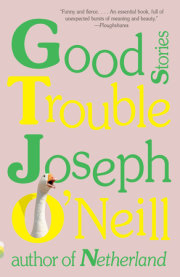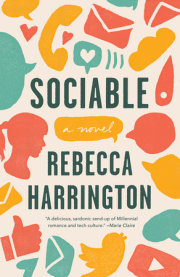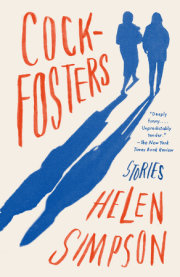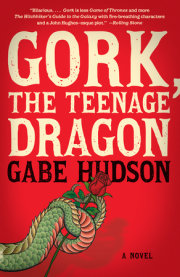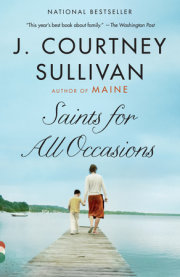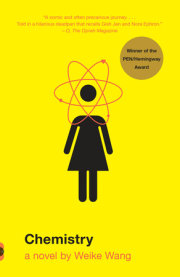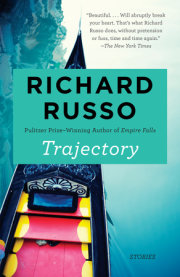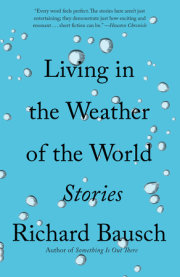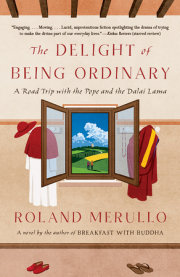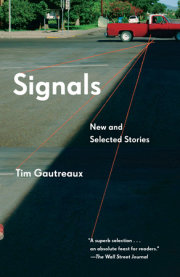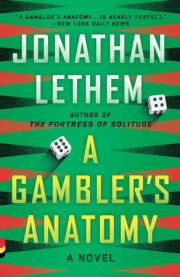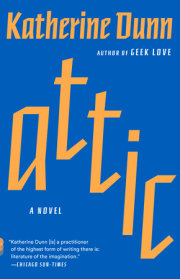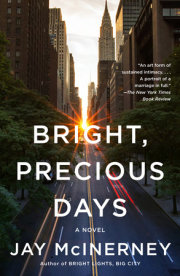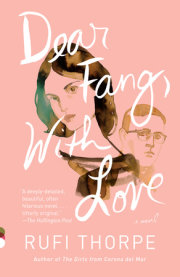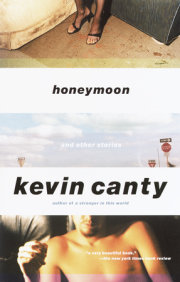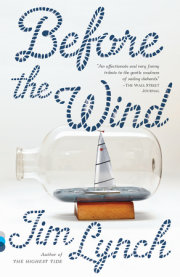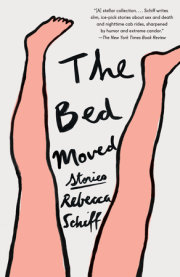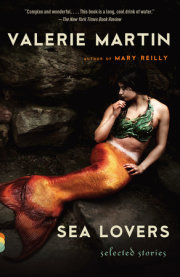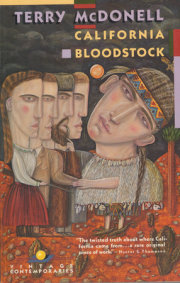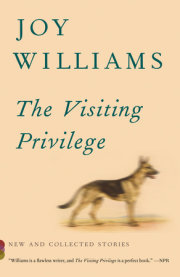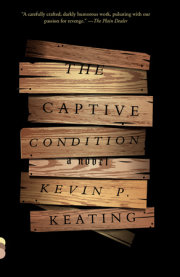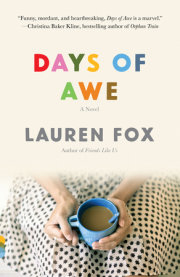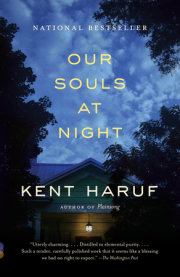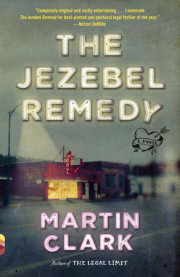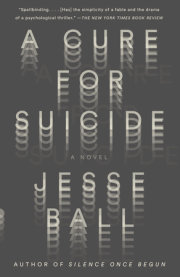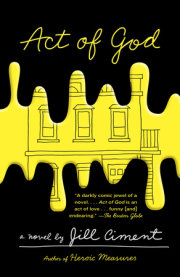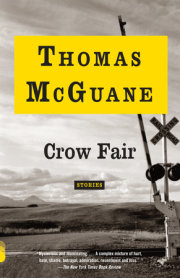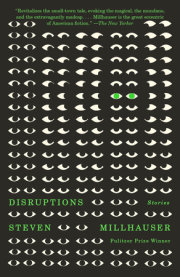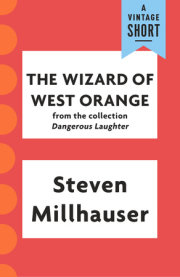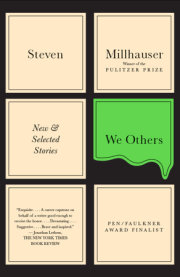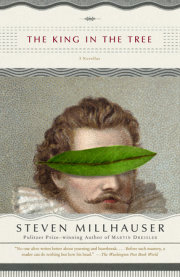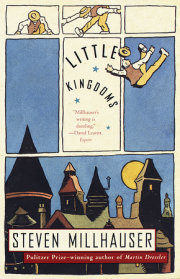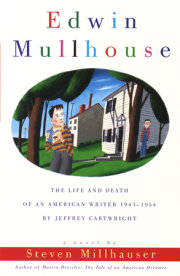Cat ’n’ mouse The cat is chasing the mouse through the kitchen: between the blue chair legs, over the tabletop with its red-and-white-checkered tablecloth that is already sliding in great waves, past the sugar bowl falling to the left and the cream jug falling to the right, over the blue chair back, down the chair legs, across the waxed and butter-yellow floor. The cat and the mouse lean backward and try to stop on the slippery wax, which shows their flawless reflections. Sparks shoot from their heels, but it’s much too late: the big door looms. The mouse crashes through, leaving a mouse-shaped hole. The cat crashes through, replacing the mouse-shaped hole with a larger, cat-shaped hole. In the living room they race over the back of the couch, across the piano keys (delicate mouse tune, crash of cat chords), along the blue rug. The fleeing mouse snatches a glance over his shoulder, and when he looks forward again he sees the floor lamp coming closer and closer. Impossible to stop—at the last moment he splits in half and rejoins himself on the other side. Behind him the rushing cat fails to split in half and crashes into the lamp: his head and body push the brass pole into the shape of a trombone. For a moment the cat hangs sideways there, his stiff legs shaking like the clapper of a bell. Then he pulls free and rushes after the mouse, who turns and darts into a mousehole in the baseboard. The cat crashes into the wall and folds up like an accordion. Slowly he unfolds, emitting accordion music. He lies on the floor with his chin on his upraised paw, one eyebrow lifted high in disgust, the claws of his other forepaw tapping the floorboards. A small piece of plaster drops on his head. He raises an outraged eye. A framed painting falls heavily on his head, which plunges out of sight between his shoulders. The painting shows a green tree with bright red apples. The cat’s head struggles to rise, then pops up with the sound of a yanked cork, lifting the picture. Apples fall from the tree and land with a thump on the grass. The cat shudders, winces. A final apple falls. Slowly it rolls toward the frame, drops over the edge, and lands on the cat’s head. In the cat’s eyes, cash registers ring up NO SALE.
The mouse, dressed in a bathrobe and slippers, is sitting in his plump armchair, reading a book. He is tall and slim. His feet rest on a hassock, and a pair of spectacles rest on the end of his long, whiskered nose. Yellow light from a table lamp pours onto the book and dimly illuminates the cozy brown room. On the wall hang a tilted sampler bearing the words HOME SWEET HOME, an oval photograph of the mouse’s mother with her gray hair in a bun, and a reproduction of Seurat’s
Sunday Afternoon in which all the figures are mice. Near the armchair is a bookcase filled with books, with several titles visible:
Martin Cheddarwit, Gouda’s
Faust,
The Memoirs of Anthony Edam,
A History of the Medicheese, the sonnets of Shakespaw. As the mouse reads his book, he reaches without looking toward a dish on the table. The dish is empty: his fingers tap about inside it. The mouse rises and goes over to the cupboard, which is empty except for a tin box with the word CHEESE on it. He opens the box and turns it upside down. Into his palm drops a single toothpick. He gives it a melancholy look. Shaking his head, he returns to his chair and takes up his book. In a bubble above his head a picture appears: he is seated at a long table covered with a white tablecloth. He is holding a fork upright in one fist and a knife upright in the other. A mouse butler dressed in tails sets before him a piece of cheese the size of a wedding cake.
From the mousehole emerges a red telescope. The lens looks to the left, then to the right. A hand issues from the end of the telescope and beckons the mouse forward. The mouse steps from the mousehole, collapses the telescope, and thrusts it into his bathrobe pocket. In the moonlit room he tiptoes carefully, lifting his legs very high, over to the base of the armchair. He dives under the chair and peeks out through the fringe. He emerges from beneath the armchair, slinks over to the couch, and dives under. He peeks out through the fringe. He emerges from beneath the couch and approaches the slightly open kitchen door. He stands flat against the doorjamb, facing the living room, his eyes darting left and right. One leg tiptoes delicately around the jamb. His stretched body snaps after it like a rubber band. In the kitchen he creeps to a moonlit chair, stands pressed against a chair leg, begins to climb. His nose rises over the tabletop: he sees a cream pitcher, a gleaming knife, a looming pepper mill. On a breadboard sits a wedge of cheese. The mouse, hunching his shoulders, tiptoes up to the cheese. From a pocket of his robe he removes a white handkerchief that he ties around his neck. He bends over the cheese, half closing his eyes, as if he were sniffing a flower. With a crashing sound the cat springs onto the table. As he chases the mouse, the tablecloth bunches in waves, the sugar bowl topples, and waterfalls of sugar spill to the floor. An olive from a fallen cocktail glass rolls across the table, knocking into a cup, a saltshaker, a trivet: the objects light up and cause bells to ring, as in a pinball machine. On the floor a brigade of ants is gathering the sugar: one ant catches the falling grains in a bucket, which he dumps into the bucket of a second ant, who dumps the sugar into the bucket of a third ant, all the way across the room, until the last ant dumps it into a waiting truck. The cat chases the mouse over the blue chair back, down the chair legs, across the waxed floor. Both lean backward and try to stop as the big door comes closer and closer.
The mouse is sitting in his armchair with his chin in his hand, looking off into the distance with a melancholy expression. He is thoughtful by temperament, and he is distressed at the necessity of interrupting his meditations for the daily search for food. The search is wearying and absurd in itself, but is made unbearable by the presence of the brutish cat. The mouse’s disdain for the cat is precise and abundant: he loathes the soft, heavy paws with their hidden hooks, the glinting teeth, the hot, fish-stinking breath. At the same time, he confesses to himself a secret admiration for the cat’s coarse energy and simplicity. It appears that the cat has no other aim in life than to catch the mouse. Although the faculty of astonishment is not highly developed in the mouse, he is constantly astonished by the cat’s unremitting enmity. This makes the cat dangerous, despite his stupidity, for the mouse recognizes that he himself has long periods when the cat fades entirely from his mind. Moreover, despite the fundamental simplicity of the cat’s nature, it remains true that the cat is cunning: he plots tirelessly against the mouse, and his ludicrous wiles require in the mouse an alert attention that he would prefer not to give. The mouse is aware of the temptation of indifference; he must continually exert himself to be wary. He feels that he is exhausting his nerves and harming his spirit by attending to the cat; at the same time, he realizes that his attention is at best imperfect, and that the cat is thinking uninterruptedly, with boundless energy, of him. If only the mouse could stay in his hole, he would be happy, but he cannot stay in his hole, because of the need to find cheese. It is not a situation calculated to produce the peace of mind conducive to contemplation.
• • •
The cat is standing in front of the mousehole with a hammer in one hand and a saw in the other. Beside him rests a pile of yellow boards and a big bag of nails. He begins furiously hammering and sawing, moving across the room in a cloud of dust that conceals him. Suddenly the dust clears and the cat beholds his work: a long, twisting pathway that begins at the mousehole and passes under the couch, over the back of the armchair, across the piano, through the kitchen door, and onto the kitchen table. On the tablecloth, at the end of the pathway, is a large mousetrap on which sits a lump of cheese. The cat tiptoes over to the refrigerator, vanishes behind it, and slyly thrusts out his head: his eyes dart left and right. There is the sound of a bicycle bell:
ring ring. A moment later the mouse appears, pedaling fiercely. He speeds from the end of the pathway onto the table. As he screeches to a stop, the round wheels stretch out of shape and then become round again. The mouse is wearing riding goggles, a riding cap, and gloves. He leans his bicycle against the sugar bowl, steps over to the mousetrap, and looks at it with interest. He steps onto the mousetrap, sits down on the brass bar, and puts on a white bib. From a pocket of his leather jacket he removes a knife and fork. He eats the cheese swiftly. After his meal, he replaces the knife and fork in his pocket and begins to play on the mousetrap. He swings on a high bar, hangs upside down by his legs, walks the parallel bars, performs gymnastic stunts. Then he climbs onto his bicycle and disappears along the pathway, ringing his bell. The cat emerges from behind the refrigerator and springs onto the table beside the mousetrap. He frowns down at the trap. From the top of his head he plucks a single hair: it comes loose with the sound of a snapping violin string. Slowly he lowers the hair toward the mousetrap. The hair touches the spring. The mousetrap remains motionless. He presses the spring with a spoon. The mousetrap remains motionless. He bangs the spring with a sledgehammer. The mousetrap remains motionless. He looks at the trap with rage. Cautiously he reaches out a single toe. The mousetrap springs shut with the sound of a slammed iron door. The cat hops about the table holding his trapped foot as the toe swells to the size of a lightbulb, bright red.
The cat enters on the left, disguised as a mouse. He is wearing a blond wig, a nose mask, and a tight black dress slit to the thigh. He has high and very round breasts, a tiny waist, and round, rolling hips. His lips are bright red, and his black lashes are so tightly curled that when he blinks his eyes the lashes roll out and snap back like window shades. He walks slowly and seductively, resting one hand on a hip and one hand on his blond hair. The mouse is standing in the mousehole, leaning against one side with his hands in his pockets. His eyes protrude from their sockets in the shape of telescopes. In the lens of each telescope is a thumping heart. Slowly, as if mesmerized, the mouse sleepwalks into the room. The cat places a needle on a record, and rumba music begins to play. The cat dances with his hands clasped behind his neck, thrusting out each hip, fluttering his long lashes, turning to face the other way: in the tight black dress, his twitching backside is shaped like the ace of spades. The mouse faces the cat and begins to dance. They stride back and forth across the room, wriggling and kicking in step. As they dance, the cat’s wig comes loose, revealing one cat ear. The cat dances over to a bearskin rug and lies down on his side. He closes his long-lashed eyes and purses his red, red lips. The mouse steps up to the cat. He reaches into his pocket, removes a cigar, and places it between the big red lips. The cat’s eyes open. They look down at the cigar, look up, and look down again. The cat removes the cigar and stares at it. The cigar explodes. When the smoke clears, the cat’s face is black. He gives a strained, very white smile. Many small lines appear in his teeth. The teeth crack into little pieces and fall out.
The cat is lying on his back in his basket in the kitchen. His hands are clasped behind his head, his left knee is raised, and his right ankle rests sideways on the raised knee. He is filled with rage at the thought of the mouse, who he knows despises him. He would like to tear the mouse to pieces, to roast him over a fire, to plunge him into a pan of burning butter. He understands that his rage is not the rage of hunger and he wonders whether the mouse himself is responsible for evoking this savagery, which burns in his chest like indigestion. He despises the mouse's physical delicacy, his weak arms thin as the teeth of combs, his frail, crushable skull, his fondness for books and solitude. At the same time, he is irritably aware that he admires the mouse's elegance, his air of culture and languor, his easy self-assurance. Why is he always reading? In a sense, the mouse intimidates the cat: in his presence, the cat feels clumsy and foolish. He thinks obsessively about the mouse and suspects with rage that the mouse frequently does not think about him at all, there in his brown room. If the mouse were less indifferent, would he burn with such hatred? Might they learn to live peacefully together in the same house? Would he be released from this pain of outrage in his heart?
The mouse is standing at his workbench, curling the eyelashes of a mechanical cat. Her long black hair is shiny as licorice; her lips look like licked candy. She is wearing a tight red dress, black fishnet stockings, and red high heels. The mouse stands the mechanical cat on her feet, unzips the back of her dress, and winds a big key. He zips up the dress and aims her toward the mousehole. In the living room, the mechanical cat struts slowly back and forth; her pointy breasts stick out like party hats. The cat’s head rises over the back of the armchair. In his eyes appear hearts pierced by arrows. He slithers over the chair and slides along the floor like honey. When he reaches the strutting cat, he glides to an upright position and stands mooning at her. His heard is thumping so hard that it pushes out the skin of his chest with each beat. The cat reaches into a pocket and removes a straw boater, which he places on his head at a rakish angle. He fastens at his throat a large polka-dot bow tie. He becomes aware of a ticking sound. He removes from his pocket a round yellow watch, places it against his hear, frowns, and returns it to his pocket. He bends close to the face of the cat and sees in each of her eyes a shiny round black bomb with a burning fuse. The cat turns to the audience and then back to the dangerous eyes. The mechanical cat blows up. When the smoke clears, the cat’s fur hangs from him in tatters, revealing his pink flesh and a pair of polka-dot boxed shorts.
Outside the mousehole, the cat is winding up a mouse that exactly resembles the real mouse. The mechanical mouse is wearing a bathrobe and slippers, stands with hands in pockets, and has a pair of eyeglasses perched at the end of its nose. The cat lifts open the top of the mouse’s head, which is attached in the manner of a hinged lid. He inserts a sizzling red stick of dynamite and closes the lid. He sets the mouse in front of the hole and watches as it vanishes through the arched opening. Inside, the mouse is sitting in his chair, reading a book. He does not raise his eyes to the visitor, who glides over with its hands in its pockets. Still reading, the mouse reaches out and lifts open the head of his double. He removes the sizzling dynamite, thrusts it into a cake, and inserts the cake into the mouse’s head. He turns the mechanical mouse around and continues reading as it walks out through the arch. The cat is squatting beside the hole with his eyes shut and his fingers pressed in his ears. He opens his eyes and sees the mouse. His eyebrows rise. He snatches up the mouse, opens its head, and lifts out a thickly frosted cake that says HAPPY BIRTHDAY. In the center of the cake is a sizzling red stick of dynamite. The cat’s fur leaps up. He takes a tremendous breath and blows out the fuse with such force that for a moment the cake is slanted. Now the cat grins, licks his teeth, and opens his jaws. He hears a sound. The cake is ticking loudly:
tock tock, tock tock. Puzzled, the cat holds it up to one ear. He listens closely. A terrible knowledge dawns in his eyes.
The cat rides into the living room in a bright yellow crane. From the boom hangs a shiny black wrecking ball. He drives up to the mousehole and stops. He pushes and pulls a pair of levers, which cause the wrecking ball to be inserted into a gigantic rubber band attached to a gigantic slingshot. The rubber band stretches back and back. Suddenly it releases the shiny black ball, which smashes into the wall. The entire house collapses, leaving only a tall red chimney standing amid the ruins. On top of the chimney is a stork’s nest, in which a stork sits with a fishing pole. He is wearing a blue baseball cap. Below, in the rubble, a stirring is visible. The cat rises unsteadily, leaning on a crutch. His head is covered with a white bandage that conceals an eye; one leg is in a cast and one arm in a sling. With the tip of his crutch, he moves away a pile of rubble and exposes a fragment of baseboard. In the baseboard we see the unharmed mousehole. Inside the mousehole, the mouse sits in his chair, reading a book.
The mouse understands that the clownishly inept cat has the freedom to fail over and over again, during the long course of an inglorious lifetime, while he himself is denied the liberty of a single mistake. It is highly unlikely, of course, that he will ever be guilty of an error, since he is much cleverer than the cat and immediately sees through every one of his risible stratagems. Still, might not the very knowledge of his superiority lead to a relaxation of vigilance that will prove fatal, in the end? After all, he is not invulnerable; he is invulnerable only insofar as he is vigilant. The mouse is bored, deeply bored, by the ease with which he outwits the cat; there are times when he longs for a more worthy enemy, someone more like himself. He understands that his boredom is a dangerous weakness against which he must perpetually be on his guard. Sometimes he thinks, If only I could stop watching over myself, if only I could let myself go! The thought alarms him and causes him to look over his shoulder at the mousehole, across which the shadow of the cat has already fallen.
The cat enters from the left, carrying a sack over one shoulder. He sets the sack down beside the mousehole. He unties a rope from the neck of the sack, plunges both hands in, and carefully lifts out a gray cloud. He places the cloud in the air above the mousehole. Rain begins to fall from the cloud, splashing down in great drops. The cat reaches into the sack and removes some old clothes. He swiftly disguises himself as a peddler and rings the mouse’s bell. The mouse appears in the arched doorway, leaning against the side with his arms folded across his stomach and his ankles crossed as he stares out at the rain. The cat removes from the sack an array of mouse-size umbrellas, which he opens in turn: red, yellow, green, blue. The mouse shakes his head. The cat removes from the sack a yellow slicker, a pair of hip boots, a fishing rod and tackle box. The mouse shakes his head. The cat removes a red rubber sea horse, a compressed-air tank, a diving bell, a rowboat, a yacht. The mouse shakes his head, steps into his house, and slams the door. He opens the door, hangs a sign on the knob, and slams the door again. The sign reads NOT HOME. The rain falls harder. The cat steps out from under the cloud, which rises above his head and begins to follow him about the room. The storm grows worse: he is pelted with hailstones the size of golf balls. In the cloud appear many golfers, driving golf balls into the room. Forked lightning flashes; thunder roars. The cat rushes around the room trying to escape the cloud and dives under the couch. His tail sticks out. Lightning strikes the tail, which crackles like an electric wire. The couch rises for an instant, exposing the luminous, electrified cat rigid with shock; inside the cat’s body, with its rim of spiked fur, his blue-white skeleton is visible. Now snow begins to fall from the cloud, and whistling winds begin to blow. Snow lies in drifts on the rug, rises swiftly up the sides of the armchair, sweeps up to the mantelpiece, where the clock looks down in terror and covers its eyes with its hands. The cat struggles slowly through the blizzard but is soon encased in snow. Icicles hang from his chin. He stands motionless, shaped like a cat struggling forward with bent head. The door of the mousehole opens and the mouse emerges, wearing earmuffs, scarf, and gloves. The sun is shining. He begins shoveling a path. When he comes to the snow-cat, he climbs to the top of his shovel and sticks a carrot in the center of the snowy face. Then he climbs down, steps back, and begins throwing snowballs. The cat’s head falls off.
The cat is pacing angrily in the kitchen, his hands behind his back and his eyebrows drawn down in a V. In a bubble above his head a wish appears: he is operating a circular saw that moves slowly, with high whining sounds, along a yellow board. At the end of the board is the mouse, lying on his back, tied down with ropes. The image vanishes and is replaced by another: the cat, wearing an engineer’s hat, is driving a great train along a track. The mouse is stretched across the middle of the track, his wrists fastened to one rail and his ankles to the other. Sweat bursts in big drops from the mouse’s face as the image vanishes and is replaced by another: the cat is turning a winch that slowly lowers an anvil toward the mouse, who is tied to a little chair. The mouse looks up in terror. Suddenly the cat lets go of the crank and the anvil rushes down with a whistling sound as the winch spins wildly. At the last moment, the mouse tumbles away. The anvil falls through the bubble onto the cat’s head.
The cat understands that the mouse will always outwit him, but this tormenting knowledge serves only to inflame his desire to catch the mouse. He will never give up. His life, in relation to the mouse, is one long failure, a monotonous succession of unspeakable humiliations; his unhappiness is relieved only by moments of delusional hope, during which he believes, despite doubts supported by a lifetime of bitter experience, that at last he will succeed. Although he knows that he will never catch the mouse, who will forever escape into his mousehole a half inch ahead of the reaching claw, he also knows that only if he catches the mouse will his wretched life be justified. He will be transformed. Is it therefore his own life that he seeks, when he lies awake plotting against the mouse? Is it, when all is said and done, himself that he is chasing? The cat frowns and scratches his nose.
The cat stands before the mousehole holding in one hand a piece of white chalk. On the blue wall he draws the outline of a large door. The mousehole is at the bottom of the door. He draws the circle of a doorknob and opens the door. He steps into a black room. At the end of the room stands the mouse with a piece of chalk. The mouse draws a white mousehole on the wall and steps through. The cat kneels down and peers into the mousehole. He stands up and draws another door. He opens the door and steps into another black room. At the end of the room stands the mouse, who draws another mousehole and steps through. The cat draws another door, the mouse draws another mousehole. Faster and faster they draw: door, hole, door, hole, door. At the end of the last room, the mouse draws on the wall a white stick of dynamite. He draws a white match, which he takes in his hand and strikes against the wall. He lights the dynamite and hands it to the cat. The cat looks at the white outline of the dynamite. He offers it to the mouse. The mouse shakes his head. The cat points to himself and raises his eyebrows. The mouse nods. The stick of dynamite explodes.
The cat enters on the left, wearing a yellow hard hat and pushing a red wheelbarrow. The wheelbarrow is piled high with boards. In front of the mousehole, the cat puts down the handles of the barrow, pulls a hammer and saw from the pile of boards, and thrusts a fistful of black nails between his teeth. He begins sawing and hammering rapidly, moving from one end of the room to the other as a cloud of dust conceals his work. Suddenly the dust clears and the cat beholds his creation: he has constructed a tall guillotine, connected to the mousehole by a stairway. The blueblack glistening blade hangs between posts high above the opening for the head. Directly below the opening, on the other side, stands a basket. On the rim of the basket the cat places a wedge of cheese. The cat loops a piece of string onto a lever in the side of the guillotine and fastens the other end of the string to the wedge of cheese. Then he tiptoes away with hunched shoulders and vanishes behind a fire shovel. A moment later, the mouse climbs the stairs onto the platform of the guillotine. He stands with his hands in the pockets of his robe and contemplates the blade, the opening for the head, and the piece of cheese. He removes from one pocket a yellow package with a red bow. He leans over the edge of the platform and slips the loop from the lever. He thrusts his head through the head hole, removes the piece of cheese from the rim of the basket, and sets the package in its place. He ties the string to the package, slides his head back through the hole, and fits the loop of the string back over the lever. From his pocket he removes a large pair of scissors, which he lays on the platform. He next removes a length of rope, which he fastens to the lever so that the rope hangs nearly to the floor. On the floor he stands cross-ankled against the wheel of the barrow, eating his cheese. A moment later, the cat leaps onto the platform. He looks up in surprise at the unfallen blade. He crouches down, peers through the head hole, and sees the yellow package. He frowns. He looks up at the blade. He looks at the yellow package. Gingerly he reaches a paw through the opening and snatches it back. He frowns at the string. A cunning look comes into his eyes. He notices the pair of scissors, picks them up, and cuts the string. He waits, but nothing happens. Eagerly he thrusts his head through the opening and reaches for the package. The mouse, eating his cheese with one hand, lazily tugs at the rope with the other. The blade rushes down with the sound of a roaring train; a forlorn whistle blows. The cat tries to pull his head out of the hole. The blade slices off the top half of his head, which drops into the basket and rolls noisily around like a coin. The cat pulls himself out of the hole and stumbles about until he falls over the edge of the platform into the basket. He seizes the top of his head and puts it on like a hat. It is backward. He straightens it with a half turn. In his hand he sees with surprise the yellow package with the red bow. Frowning, he unties it. Inside is a bright red stick of dynamite with a sizzling fuse. The cat looks at the dynamite and turns his head to the audience. He blinks once. The dynamite explodes. When the smoke clears, the cat’s face is black. In each eye a ship cracks in half and slowly sinks in the water.
• • •
The mouse is sitting in his chair with his feet on the hassock and his open book facedown on his lap. A mood of melancholy has invaded him, as if the brown tones of his room had seeped into his brain. He feels stale and out of sorts: he moves within the narrow compass of his mind, utterly devoid of fresh ideas. Is he perhaps too much alone? He thinks of the cat and wonders whether there is some dim and distant possibility of a connection, perhaps a companionship. Is it possible that they might become friends? Perhaps he could teach the cat to appreciate the things of the mind, and learn from the cat to enjoy life’s simpler pleasures. Perhaps the cat, too, feels an occasional sting of loneliness. Haven’t they much in common, after all? Both are bachelors, indoor sorts, who enjoy the comforts of a cozy domesticity; both are secretive; both take pleasure in plots and schemes. The more the mouse pursues this line of thought, the more it seems to him that the cat is a large, soft mouse. He imagines the cat with mouse ears and gentle mouse paws, wearing a white bib, sitting across from him at the kitchen table, lifting to his mouth a fork at the end of which is a piece of cheese.
The cat enters from the right with a chalkboard eraser in one hand. He goes over to the mousehole, bends down, and erases it. He stands up and erases the wall, revealing the mouse’s home. The mouse is sitting in his chair with his feet on the hassock and his open book facedown on his lap. The cat bends over and erases the book. The mouse looks up in irritation. The cat erases the mouse’s chair. He erases the hassock. He erases the entire room. He tosses the eraser over his shoulder. Now there is nothing left in the world except the cat and the mouse. The cat snatches him up in a fist. The cat’s red tongue slides over glistening teeth sharp as ice picks. Here and there, over a tooth, a bright star expands and contracts. The cat opens his jaws wider, closes his eyes, and hesitates. The death of the mouse is desirable in every way, but will life without him really be pleasurable? Will the mouse’s absence satisfy him entirely? Is it conceivable that he may miss the mouse, from time to time? Is it possible that he needs the mouse, in some disturbing way?
As the cat hesitates, the mouse reaches into a pocket of his robe and removes a red handkerchief. With swift circular strokes he wipes out the cat’s teeth while the cat’s eyes watch in surprise. He wipes out the cat’s eyes. He wipes out the cat’s whiskers. He wipes out the cat’s head. Still held in the cat’s fist, he wipes out the entire cat, except for the paw holding him. Then, very carefully, he wipes out the paw. He drops lightly down and slaps his palms together. He looks about. He is alone with his red handkerchief in a blank white world. After a pause, he begins to wipe himself out, moving rapidly from head to toe. Now there is nothing left but the red handkerchief. The handkerchief flutters, grows larger, and suddenly splits in half. The halves become red theater curtains, which begin to close. Across the closing curtains, words write themselves in black script: THE END.
Copyright © 2008 by Steven Millhauser. All rights reserved. No part of this excerpt may be reproduced or reprinted without permission in writing from the publisher.


